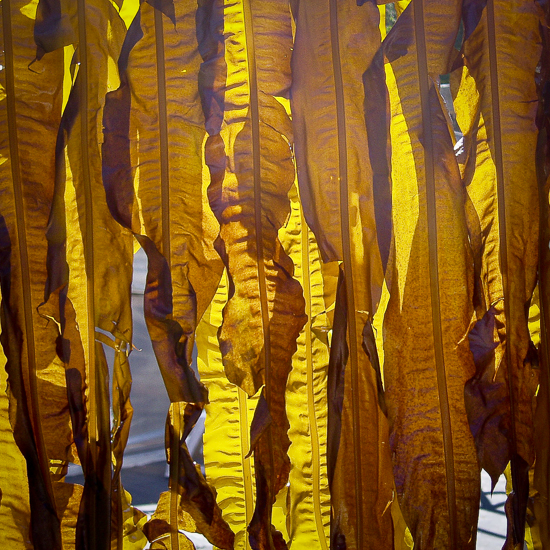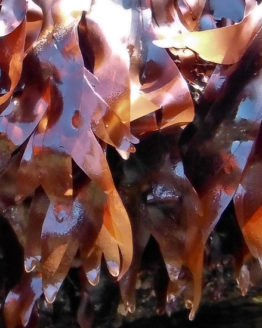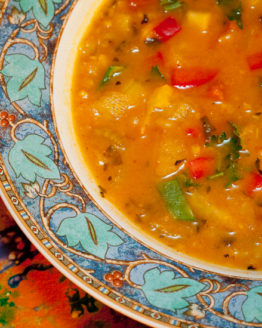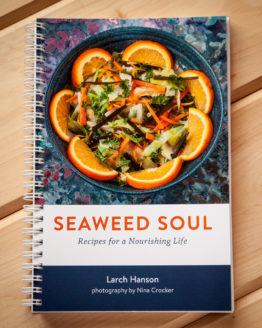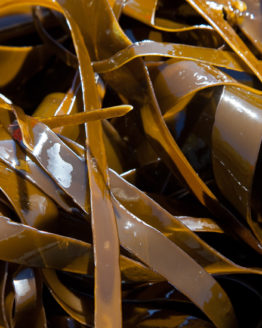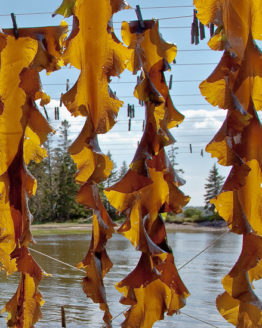Description
Alaria Preparation & Basics
In the kitchen, the quick way to cut dry alaria is with a scissors. You can also soak alaria, then use a knife to cut it. Since alaria expands as it rehydrates, the second method of cutting alaria (after it has rehydrated, with a knife) will give you more control over the size of your final pieces. Don’t throw away the soaking water! This water contains minerals. For instance, alaria is high in calcium. It’s comparable to whole sesame seeds as far as calcium content (1,100 mg/100 g) and has high vitamin A content (8487 IU/100 g) similar to parsley and spinach. It’s a wise choice for nourishing your bones. It’s rich in B complex vitamins, vitamin C & K. It has moderate iodine, good for everyone, especially those with type A or B blood. Use the soak water for cooking. Pre-soaking alaria is a way of tenderizing it. Pre-soak alaria for at least an hour, until the midrib is thoroughly rehydrated.
Total cooking time for alaria (slow boil/fast simmer) needs to be at least 20-40 minutes. Remember that this isn’t like Japanese wakame which is often parboiled before drying to make it tender (and also results in the loss of minerals!). After 20-40 minutes of simmering, add sliced vegetables. The simplest combination would be one part alaria to four parts carrots. Cook until the carrots are tender. Add tamari to taste. Sometimes I throw in a couple of cloves, and it seems to work. Another simple combination is one part alaria, four parts green beans and a handful of almonds or sliced almonds, cooked until the beans are tender. Add a dash of tamari and a sprig of parsley. Another way to handle this dish would be to simmer the alaria until tender, place the green beans in boiling water for two minutes, drain and run under cold water to retain crispness and color, and then sauté the green beans in a cast-iron skillet on medium-high heat for three minutes (use refined sesame oil), add alaria and continue to sauté for three to four minutes. Remove from heat and season with tamari and add tamari-roasted almonds or sliced almonds. Pecans will work, too. Serve hot or cold.
Alaria is delicious when cooked with rice, barley, or millet. Cooked with beans (adukis, lentils, pintos, etc.), alaria will impart a rich “gravy” texture and help make the beans more digestible.
Alaria Overview
I was a boy, looking into my father’s eyes, the night he died of cancer. It took me years, healing my grief and loss of him, before I was able to realize that his mind essence had been transferred to me. Occasionally, a channel or a psychic will pick up on the link he and I have, and the message is always some variation of “He wants you to know that he never left you.” One particular psychic relayed this message: “He wants you to know that the alaria you harvest could have helped to heal his cancer.”
This message came after Jane Teas, a cancer researcher, had used alaria in a nutritional study with breast cancer survivors, and her opinion was that alaria helps strengthen the immune system against cancer. I was guided by my dad to settle in this place where a lot of beautiful alaria grows in the surf.
The Pacific cousin of alaria is wakame, and you may substitute alaria in any recipe that calls for wakame. Alaria grows about a foot a week in May and June. Yesterday I watched my son Jay harvesting alaria on a ledge that was being intermittently covered over by three foot high surf swells.
When the wave surged over him, he hung on to the alaria like a rock climber grabbing his rope.
When the wave retreated, he cut himself free and walked the alaria to a bushel basket on higher ledge. Jay has the same tenacity and flexibility as alaria, and it’s a joy to watch him working/playing in the surf.
Alaria is one of the most versatile sea vegetables that we harvest. The plants are 6-12 feet long, graceful and delicate, yet strong. They are olive-brown flat ribbons 1-3″ wide with midribs that flash golden in the water. Alaria has a very clean smell and a mild taste. It grows in open surf, some of the most highly charged water on the planet. Alaria dancing in the surf reminds me of a beautiful ballerina: strong, yet gentle and graceful. Harvesting alaria in surf demands a sure agility and a consciousness that is constantly in present moment: I spot the alaria I want to cut, a wave covers it, but I remain focused on the spot and grab a hank of the alaria at its base as the wave goes out; another wave comes and covers me as I tenaciously hang on to the hank of alaria and cut it free from the ledge; the wave recedes, and I walk out of the surf, dragging the eight foot long hank of alaria firmly grasped in my hand, ready to be trimmed and swirled into a basket. Ho hum, another day at the office…..mid-June, new moon tide, first light at 4 a.m., Eastern Island, birds just waking up, baby seals in the water calling to their mothers. Soon the sun will appear.
